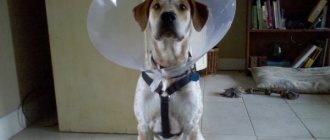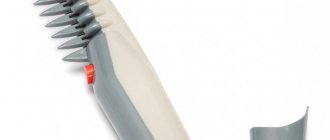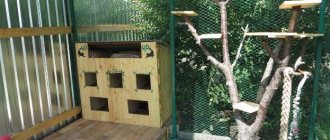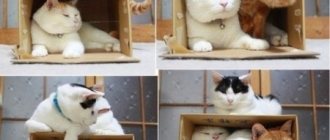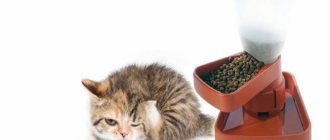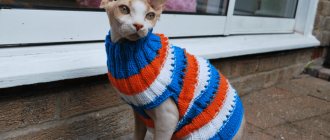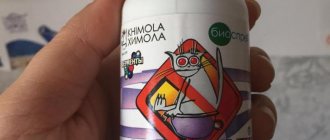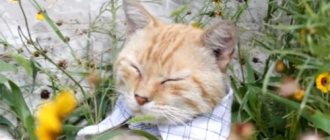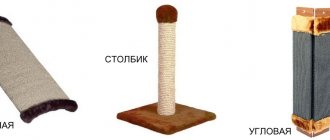What will you learn from the article?
- DIY Cardboard
- Made from lightweight plastic
- From a plastic bottle
- Soft fabric collar
- Collar made from scrap materials
- Plastic
- When to use a collar
A cat collar is a veterinary accessory that helps cat owners solve many problems. The device prevents cats from licking, scratching and biting wounds on their bodies, or licking off medicine applied to the body.
The special collar has several names - veterinary, medical, Elizabethan. In foreign sources the name appears - E-collar. But no matter what this accessory is called, it has one purpose - to protect the cat from itself.
In this article, we will take a closer look at this useful device that helps veterinarians and cat owners; we will talk about methods of its use, functionality and rules of use.
Let's start with how to make a collar with your own hands.
Selection rules
The protective device causes quite a lot of discomfort to the pussy. In order not to aggravate the situation, when purchasing a plastic collar for a cat, you need to pay attention to the following points:
- Choose an option according to the size of your pet;
- Opt for a transparent option - the collar already obscures the view, and if the cat cannot see through the collar, he will become nervous and try to remove it;
- Pay attention to the design of the collar - purchase the version with Velcro.
Satisfactory height and strength are important. The collar should not completely block the cat's view, but at the same time not be too low and allow her to lick the wounds.
The protective device should hold its shape well, fit properly and not be too tight.
Most collars are made in the form of a semicircle with fastening tabs. It is very difficult to put them on a purr, sometimes one person cannot cope with this and you have to resort to help. It is better to buy the version with Velcro. Yes, the price of such a cat collar will be higher, but there will be much fewer problems with attaching it.
How to choose the size for your dog?
It is important not only to choose a convenient model, but also to take care of the correct dimensions of the product. How to choose a collar for a dog so that the design does not interfere with eating, does not reduce visibility and does not hinder movement?
You should start from the width of the barrier field:
- for miniature breeds, No. 10, 12 are suitable;
- for medium-sized pets – No. 15;
- large breeds - No. 20, 25.
| Size | Height | External diameter | Neck circumference |
| 9 | 7,5 | 13-15 | 7-8 |
| 8 | 10 | 16-18 | 8-9 |
| 7 | 12,5 | 19-21 | 9-10,5 |
| 6 | 15 | 23-27 | 10-12 |
| 4 | 25 | 34-42 | 14-16 |
| 3 | 30 | 41-48 | 15-18 |
| 2 | 35 | 41-48 | 15-18 |
| 1 | 40 | 50-60 | 21-25 |
The Elizabethan collar requires self-assembly of the structure after purchase. This is not difficult to do if you carefully study the instructions. Usually the plastic base is bent into the shape of a cone and fixed with special devices. If the size is chosen appropriately, then the brim of the cone slightly protrudes beyond the outline of the dog’s head.
Usage
Buying a collar is only half the battle. The main thing is to secure it correctly and not create additional obstacles and difficulties for your pet.
- It is very rare that you can choose an option that allows your cat to drink water and eat food from its usual bowls without any problems.
- Most often, the owner has to remove the collar so that the pussy can drink and eat.
- It is necessary to carefully monitor the furry person. As soon as she has eaten and drunk, she must immediately put the device in place.
- If you are distracted or simply hesitate, the cat will begin to lick itself, and this is fraught with serious problems.
Before purchasing, looking at photographs of cat collars that are posted on the websites of zoological stores and choosing the best option, know that even if you buy the most expensive and high-quality product, you may still encounter difficulties.
- For example, an animal constantly clings to something. This problem most often occurs when the collar length is too long.
- The simplest solution is to cut off a small piece and see how much this measure helped the cat.
- It is also possible to cope with neck chafing at home. There are two options - you have tightened the collar too tightly - you need to loosen its “grip”.
- It's very simple to check - the owner's finger should pass between the pet's neck and the collar.
- Sharp, scratchy edges of the collar must be covered with tape so that the device will not rub your pet’s neck.
But if your pussy walks with its head down all the time, it means the device is made of too heavy a material and you will have to buy another thing.
Caring for a cat in the first postoperative hours
After the operation, the cat will be very weak for the first three hours. He will experience dizziness, nausea, thirst, and muscle weakness. This is a normal condition that should not bother the owner, so the pet will recover from anesthesia.
The owner may be offered to leave the pet on the first day at the clinic, under the supervision of a doctor, but he will be there in a stressful state. Therefore, it is better to take him home so that the cat feels the care and participation of the owner.
During the postoperative period, the cat experiences:
- Dry eyes. During anesthesia, cats' eyes do not close, they remain open. During the operation, the veterinarian closes the animal's eyelids from time to time so that the conjunctiva is moistened with tears. If the cat has not yet recovered from anesthesia, then the owner will have to do this.
- In order to properly care for your pet's eyes, you need to buy tetracycline eye ointment or antiseptic drops. After the pet has recovered from anesthesia, there is no need to close his eyes; he will do this on his own. There are times when an animal lies for a long time with its eyes open, then it is necessary to drip saline solution into the eyes. This will save them from dryness.
- Low body temperature. The usual cat temperature is 37.5 – 39.0 degrees Celsius. In the postoperative period, the temperature can drop to 36.5 - 37.0 degrees. The cat should be placed on a warm bedding and covered with a warm blanket. In extreme cases, the cat can be warmed with a heating pad. To normalize blood circulation, he needs to rub his ears and paws.
- Unsteady gait. This is due to the relaxation of muscles during the application of anesthesia. Usually during this period the cat walks with a staggering gait. On the first day, you should better monitor your pet so that he does not climb to any height, otherwise he may not be able to hold on and fall.
- At first, the cat needs painkillers. If your pet is silent, this does not mean that he does not feel pain. Most animals silently endure pain. They completely refuse food and are in a motionless position. Their pupils, as a rule, are dilated and concentrated. The gaze is fixed on one point.
We do it ourselves
Rarely, but it is also possible that the nearest pet stores do not have a collar suitable for your cat. Anyone can cope with this trouble.
The device can be made from:
- Cardboard;
- Plastic bottle;
- Foam plastic;
- Matter.
The cat can quickly cope with a structure made of cardboard and fabric. The foam model is a kind of frill, which can become an effective protection for wounds on the back, stomach or sides, but the cat can reach its paws.
The most suitable material would be plastic. Let's take a closer look at how to make a cat collar with your own hands at home.
Tools and materials
Nothing fancy is required. It is enough to have a plastic cloth, a sharp knife, a felt-tip pen and tape on hand.
In order not to make a mistake with the dimensions, you should make a pattern, and for this prepare:
- A sheet of paper (a double piece of paper from a school notebook);
- Ruler;
- Pencil;
- Compass;
- Centimeter.
Progress
You need to start making a veterinary collar for a furry pet by creating a pattern. To do this, you will need to take two measurements - neck circumference and the distance from the tip of the nose to the cat's neck.
Next steps:
- Two circles are drawn on a piece of paper: one is the size of the neck circumference, the second is the distance from the nose to the neck (two to three centimeters should be added). The center for both circles must be common.
- Inside the smaller circle (we step back a couple of centimeters from the edges) another circle is drawn where the clasps for the collar will be located.
- The pattern is cut along a large circle (you can make an allowance of a few centimeters).
- The next step is to cut the workpiece straight from the edge to the center.
- The smallest circle is cut out.
- We try the pattern on the cat and make adjustments if necessary.
- We place the pattern on plastic and use a felt-tip pen to outline the contours.
- We fix the places for the loops.
- We thread a bandage (rope) through the loops and secure the entire structure to the animal.
The result is a collar that is practically no different from the factory sample.
Simple option
You can make a design using only a sharp knife, tape and a five-liter plastic bottle. The collar will not be as elegant as in the first version, but quite suitable for use.
In this case, to make a cat collar with your own hands, you only need a few simple operations.
- The top is cut off from a plastic bottle.
- Then the place where the lid is located is cut off.
- The resulting workpiece in the form of a semicircle without a bottom and top is cut vertically.
- We try on how well it fits on the cat’s neck and see if the furry creature’s curious nose sticks out from the structure.
- All edges of the plastic rim are covered with tape.
- The headband is put on the cat. The edges of the structure overlap each other and are secured with tape.
The veterinary collar for your beloved cat is ready!
Operating instructions
The benefit of a protective accessory is observed when the cat cannot independently remove the structure from the body and deform it with its paws. When wearing them, it is not allowed to block the side view, make breathing difficult, or rub the skin in the neck area. These results are achieved by matching the size of the collar and the dimensions of the cat.
Size chart for barrier therapy medical devices for cats:
| Accessory size | Neck length | Collar width | Who is it suitable for? |
| №1 | 15-17 cm | 8 cm | kittens |
| №2 | 20-24 cm | 10.5 cm | teenagers |
| №3 | 27-31 cm | 12 cm | average cat |
| №4 | 30-34 cm | 14 cm | big cats |
Veterinary devices that protect animals from self-harm are sold in finished form. Their assembly is carried out according to the scheme prescribed in the instructions.
Step-by-step connection of the components of the collar with the straps:
- The right edge of the structure with slotted holes overlaps the paired holes on top.
- A long strip is inserted into rectangular passages.
- Short straps are tucked into the upper paired holes.
- The animal's collar is threaded through the formed slot holes.
Protective item with straps for a cat, assembled.
Veterinary barrier therapy products with Velcro are assembled faster. To do this, just put them on the animal’s neck and then secure it with a textile fastener.
All medical collars without side effects or contraindications. There are no precautions for use. They are stored in a dry, dark place, with a relative humidity of no more than 75%.
Shelf-life Unlimited.
Replacement option
If your pet does not want to put up with a device on his neck, you will have to buy or sew him a dress that will cover the wound.
Just keep in mind that this option is not suitable in all cases.
When treating wool and skin with various medications, you cannot do without a collar.
Coming out of anesthesia: what to pay attention to
You will have to write a separate article about the types of anesthesia. Therefore, there are no uniform recommendations. After gas (inhalation) anesthesia, the dog will be given to you almost fully conscious. If intravenous anesthesia (propofol) was used, then the animal also comes to its senses within half an hour.
Intramuscular anesthesia is another matter. If you do not use a special drug that brings the dog out of anesthesia (Antisedan, Antimedin, Alzan), then the animal will be “drunk” for a long time. It is precisely such an unconscious patient that needs constant supervision.
We recommend reading: Bravecto for dogs - instructions for using tablets
Labrador recovers from anesthesia
Do not try to immediately pick up your pet. If the dog is still sleeping, it is much safer to lay it on a flat surface, on its side. Doctors pull the tongue out of the mouth, hanging to one side. It can be moistened with a wet hand to prevent it from drying out. When waking up, vomiting may begin, although with a proper fasting diet it almost never happens.
The dog should breathe evenly and deeply. Breathing should be monitored especially carefully in brachiocephalic breeds. In a bulldog or pug, a long velum palatine may block the entrance to the trachea. A half-asleep pet will quietly gasp, and only by the purple color of its tongue will the owner understand that it’s time to sound the alarm.
Waking up from anesthesia, the dog may behave absolutely inappropriately - not recognizing the owner, biting the hand that strokes his face. Some dogs begin to bark and whine, not because they are in pain, but because the nervous system is excited.
The dog will try to get up, fall, kick his legs
It is very important to prevent injury. Do not place your pet on a slippery floor, encourage activity
The dog is calmed with a voice and sat down, not allowed to rush about
Decorative dogs are carefully picked up
Large dogs are laid to sleep on the floor
If the clinic's capabilities allow, owners should not be left alone with a pet that has not fully recovered from anesthesia. He must be supervised by staff.
